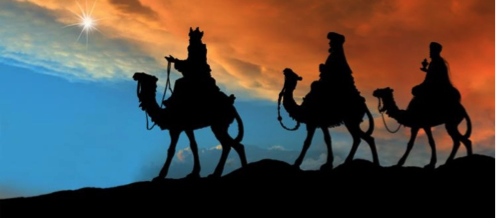
From a liturgical point of view, each year the Christmas Season begins at sunset on Christmas Eve and ends at sundown on the Feast of the Baptism of the Lord which is Sunday, January 10th this year. (Don’t throw out your Christmas tree before then, or I’ll haunt you worse than the ghost of Jacob Marley haunted his old business partner, Scrooge!). Getting back to liturgy, we could subdivide the Christmas Season into two seasons.
The first division is Christmas, the Season of Peace, and would include the Solemnity of Christmas right up to the night before Epiphany. In some countries the Feast of Epiphany is still traditionally celebrated on January 6th regardless of what day of the week January 6th falls on. From Christmas Day until January 6th, we have 12 days, hence the expression “the 12 Days of Christmas” or “Twelfth Night”. We call that a “fixed” feast. Christmas is a “fixed” feast as it is always celebrated on December 25th no matter what day of the week the 25th falls on. (Easter, on the other hand, is a “movable” feast which means it is not celebrated on the same calendar day each year but “moves” according to the lunar calendar). While some countries, like Greece and Poland, continue to celebrate Epiphany on January 6th each year, as a “fixed” feast, most countries, including Canada have long since moved the celebration of Epiphany to a Sunday (Sunday, January 3rd this year).
Now we get to our second division within the larger Christmas Season, Epiphany, the Season of Revelation. This season unfolds from the Feast (really a solemnity) of Epiphany (Sunday, January 3rd) until the Feast of the Baptism of the Lord, also on a Sunday (Sunday, January 10th). Epiphany, as you Child bringing their gifts and acknowledging Jesus as know, celebrates the visit of Wise Men to the Christ the light to the nations. The word “epiphany” has its origin in Greek meaning: an appearance, a manifestation, a revelation, a showing, an uncovering. What was revealed in Jesus is that he is the light, to not only the Jews, but also to the non-Jews (Gentiles); in other words, he is the Light of the World.
Back in 2002, St. Pope John Paul II, invited us to pray the rosary a little differently. He introduced us to another set of mysteries of the rosary, although the idea was hatch back in 1957. Along with the traditional mysteries (Joyful, Sorrowful, Glorious), Pope John Paul invited us to pray the Luminous Mysteries as well. He felt, and I agree, that without the Luminous Mysteries, the rosary is without any reference to Jesus’ adult ministry. (The Joyful deal with Jesus up until he was 12. The Sorrowful focus on Jesus’ last 24 hours of earthly life. The Glorious concentrate on Jesus’ post-resurrection life). The luminous mysteries are about Jesus’ adult life and his ministry (the baptism in the Jordan, the wedding feast at Cana, the proclamation of the Kingdom, the Transfiguration, the Eucharist). The luminous mysteries are well-named. These five pivotal moments in the life of Jesus really do shed light on the truth of who Jesus was and continues to be for us.
In the Incarnation, the coming of God in the flesh of Jesus, the lid is blown off the pot, and we get to see inside. We get to see the face of God. Moreover, each time we look into the face of another human being, the face of God is revealed anew. The light that never stops shining, the light that scatters the darkest realities, is a light that came to us at Christmas and never left us. Let’s live in the light. It’s Epiphany all year round.
Fr. Phil Mulligan
DEC
2020

About the Author: